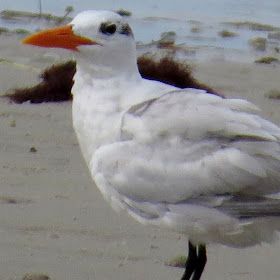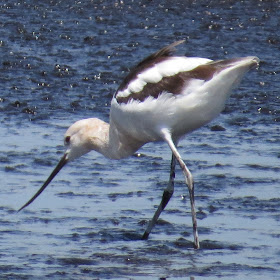Tuesday, August 25th
 |
| Egrets and Anhingas at roost at Brown's Farm Road |
Today,
Bob Pelkey and I returned to the Everglades Ag Area south of Belle Glade in Palm Beach County to look for birds we missed three weeks ago. These targets included upland sandpiper, buff-breasted sandpiper wilson's phalarope and barn owls.
We arrived at sunrise at Brown's farm Road and CR 880 to find the heron roost there loaded with egrets, herons, anhingas, night-herons and ibis.
We then moved on and checked a couple of flooded fields in the area. The wading and shorebird numbers were down, but the number of swallows had swollen, especially Barn Swallows. We also found Cliff, Bank and FOS Tree Swallows. One of these flooded fields was very active and had been the sight of reported wilson's phalaropes just three days prior. Bob and scoped the site for an hour and a half without sighting the phalaropes. We did find Black-bellied and Fulvous Whistling Ducks, FOS Blue winged Teal, Mottled Duck, American Avocet, Greater and Lesser Yellowlegs, Least Sandpipers, Pectoral Sandpipers, Stilt Sandpipers, Long-billed Dowitchers, Black-necked Stilts, Common gallinule and American Coots
|
|
| Juvenile Tricolored Heron. Note the strange bill on this bird |
 |
| A young Barn Swallow |
 |
| Bank Swallow |
 |
| Black-necked Stilt |
 |
| Lesser Yellowlegs |
 |
| Lesser Yellowlegs |
We then checked the sod fields at 8-mile bend and King Ranch properties for grass peeps and found them virtually devoid of migrant birds.
So we had dipped on three of our four targets of the day, which just left us to check out the barn owl roost on Miami Canal. We initially believed that we had missed out here. But as Bob was maneuvering his camera to get a good shot of out FOS Eastern Kingbird, a Barn Owl burst out from cover and immediately disappeared deeper into the stand.
A last stop was made in Clewiston, at the Hoover Dike to look for any bronze cowbirds. What we did see were about fourteen Swallow-tailed Kites soaring westerly with a high flying Cooper's Hawk diving at a couple of the kites. Not sure why the hawk has attaching the kites, but it was an entertaining conclusion for the trip.
 |
| Common NightHawk |
 |
| Cattle Egret |
 |
| Red-shouldered Hawk |
 |
| Great Egrets |
Compilation Bird Lists from Both Visits this Month - (81)
 |
| Great Egret |
Black-bellied
Whistling-Duck, Fulvous Whistling-Duck, Mottled Duck, Blue-winged Teal,
Northern Bobwhite, Pied-billed Grebe, Wood Stork, Double-crested Cormorant,
Anhinga, American White Pelican, Great Blue Heron, Great Egret, Snowy Egret, Little
Blue Heron, Tricolored Heron, Cattle Egret, Green Heron, Black-crowned
Night-Heron, Yellow-crowned Night-Heron, White Ibis, Glossy Ibis, Roseate
Spoonbill, Turkey Vulture, Black Vulture, Osprey, Swallow-tailed Kite, Cooper's
Hawk, Bald Eagle, Red-shouldered Hawk, King Rail, Purple Gallinule, Gray-headed
Swamphen, Common Gallinule, American Coot, Limpkin, Sandhill Crane, Black-necked
Stilt, American Avocet, Semipalmated Plover, Killdeer, Spotted Sandpiper, Solitary
Sandpiper, Least Sandpiper, Greater Yellowlegs, Lesser Yellowlegs, Stilt
Sandpiper, Pectoral Sandpiper, Western Sandpiper, Long-billed Dowitcher, Laughing
Gull, Least Tern, Gull-billed Tern, Black Tern, Black Skimmer, Rock Pigeon, Eurasian
Collared-Dove,
Common
Ground-Dove, White-winged Dove, Mourning Dove, Barn Owl, Common Nighthawk, Belted
Kingfisher, Eastern Kingbird, Fish Crow, Purple Martin, Tree Swallow, Bank
Swallow, Barn Swallow, Cliff Swallow, Blue-gray Gnatcatcher, Northern
Mockingbird, European Starling, Common Yellowthroat, Prairie Warbler, Red-winged
Blackbird, Eastern Meadowlark, Common Grackle, Boat-tailed Grackle, Brown-headed
Cowbird and House Sparrow
 Roseate Spoonbill
Roseate Spoonbill



























































